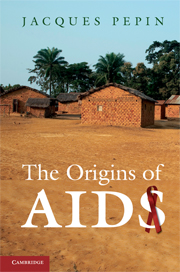Book contents
- Frontmatter
- Contents
- Figures, maps and table
- Acknowledgements
- Abbreviations
- Note on terminology
- Introduction
- 1 Out of Africa
- 2 The source
- 3 The timing
- 4 The cut hunter
- 5 Societies in transition
- 6 The oldest trade
- 7 Injections and the transmission of viruses
- 8 The legacies of colonial medicine I
- 9 The legacies of colonial medicine II
- 10 The other human immunodeficiency viruses
- 11 From the Congo to the Caribbean
- 12 The blood trade
- 13 The globalisation
- 14 Assembling the puzzle
- 15 Epilogue
- References
- Appendix Classification of retroviruses
- Index
10 - The other human immunodeficiency viruses
Published online by Cambridge University Press: 05 June 2012
- Frontmatter
- Contents
- Figures, maps and table
- Acknowledgements
- Abbreviations
- Note on terminology
- Introduction
- 1 Out of Africa
- 2 The source
- 3 The timing
- 4 The cut hunter
- 5 Societies in transition
- 6 The oldest trade
- 7 Injections and the transmission of viruses
- 8 The legacies of colonial medicine I
- 9 The legacies of colonial medicine II
- 10 The other human immunodeficiency viruses
- 11 From the Congo to the Caribbean
- 12 The blood trade
- 13 The globalisation
- 14 Assembling the puzzle
- 15 Epilogue
- References
- Appendix Classification of retroviruses
- Index
Summary
Although they contribute little to the overall burden of AIDS in the world, the other HIVs (HIV-1 groups O, N and P, and HIV-2) can provide useful insight into the events that led to the emergence of pandemic HIV-1 group M. How was it possible for HIV-2, a different virus that originated from a different simian host, to spread in a different region of Africa at roughly the same time (give or take a few decades) as HIV-1, only to disappear quietly thereafter? And why was HIV-1 group M so successful compared to the others?
HIV-1 groups O, N and P
Highly divergent strains of HIV-1 were described in the 1990s. The first, now known as HIV-1 group O (‘O’ for outlier), has only 50–65% homology in nucleotide sequences compared to HIV-1 group M, which is why it is considered as a different ‘group’ rather than a different ‘subtype’ (subtypes differ by about 20%; in other words, they have 80% homology). The original isolates of HIV-1 group O had been obtained from two Cameroonians living in Belgium, a young woman and her husband. Additional cases were documented among Cameroonians living in France, and in Cameroon itself. Further studies confirmed that Cameroon was the epicentre of HIV-1 group O, where it accounted for 2% of all HIV-1 infections, versus 1% in adjacent Gabon and Nigeria. A few cases were found in other African countries. Within Cameroon, regional variations were noted, with group O representing 6% of all HIV-1 positive sera in Yaoundé but only 1% in northern provinces. When stored sera were tested, group O represented 21% of all HIV-1 positive sera in 1986–8, 9% in 1989–91, 3% in 1994–5 and only 1% in 1997–8. It then remained rather stable at 1–2%.
- Type
- Chapter
- Information
- The Origins of AIDS , pp. 168 - 179Publisher: Cambridge University PressPrint publication year: 2011



